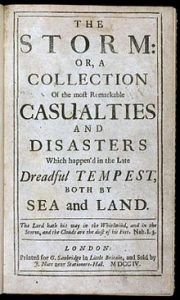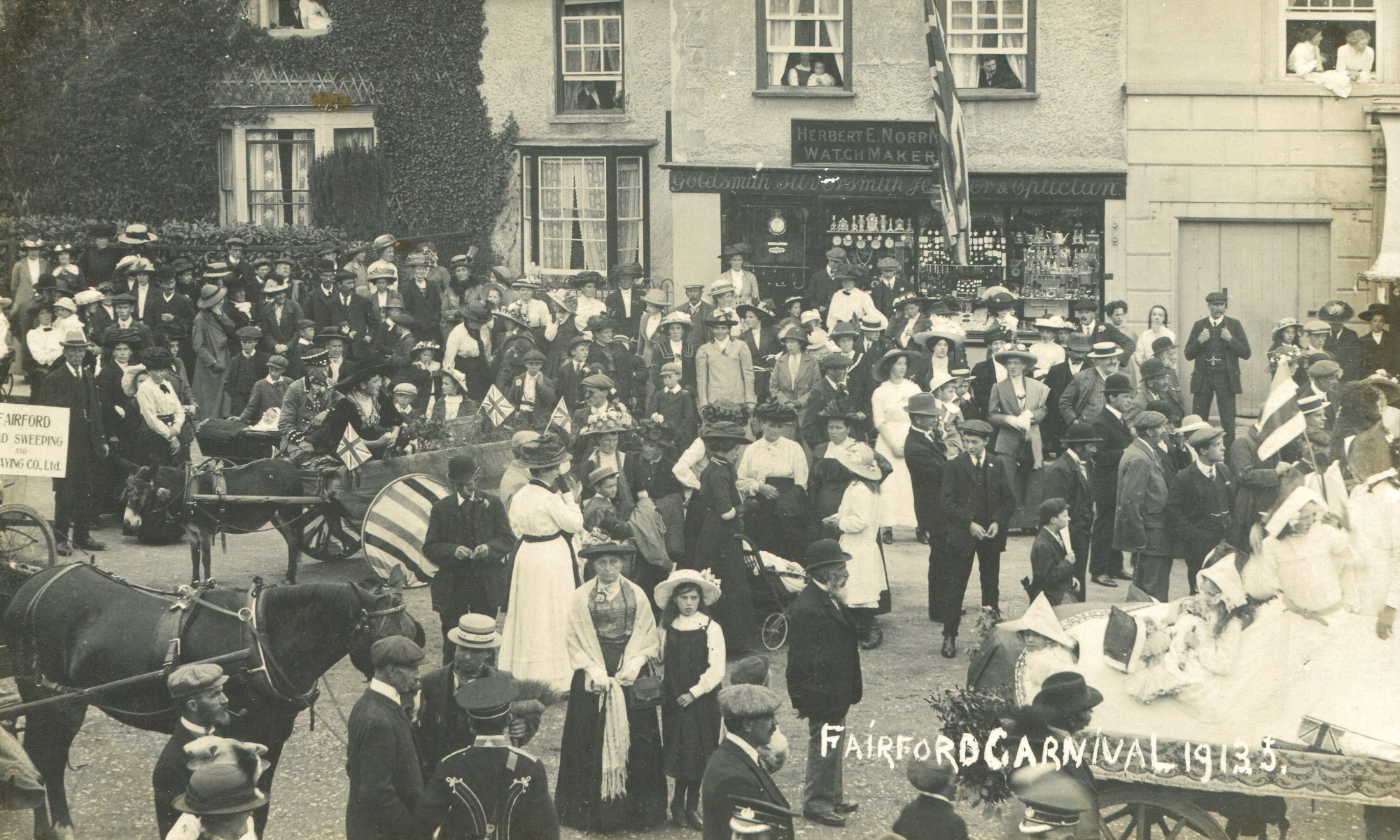 The Great Storm of 26 November 1703 was one of the most powerful and destructive storms in recorded English history. The storm came in from the Atlantic and cut a swathe of destruction across southern and central England and out into the North Sea. In London about 2,000 chimney stacks were blown down and at least 1,500 men were lost at sea as many ships, including the Royal Navy’s entire Channel Squadron, were sunk. One warship was blown from Harwich all the way to Gothenburg in Sweden before it was able to sail back to England. There was extensive flooding in the West Country where hundreds of people and thousands of livestock were drowned in the Somerset Levels. Other instances of destruction include about 400 windmills which were destroyed, about 4,000 oak trees in the New Forest blown down, and the collapse of the first Eddystone Lighthouse.
The Great Storm of 26 November 1703 was one of the most powerful and destructive storms in recorded English history. The storm came in from the Atlantic and cut a swathe of destruction across southern and central England and out into the North Sea. In London about 2,000 chimney stacks were blown down and at least 1,500 men were lost at sea as many ships, including the Royal Navy’s entire Channel Squadron, were sunk. One warship was blown from Harwich all the way to Gothenburg in Sweden before it was able to sail back to England. There was extensive flooding in the West Country where hundreds of people and thousands of livestock were drowned in the Somerset Levels. Other instances of destruction include about 400 windmills which were destroyed, about 4,000 oak trees in the New Forest blown down, and the collapse of the first Eddystone Lighthouse.
Amongst the list of damage done by the storm can be added Fairford’s church and its nationally-important windows. Soon after the storm the author Daniel Defoe (who would later write the novel Robinson Crusoe) asked for first-hand accounts of the effects of the storm with the aim of writing a detailed account of the disaster which was published in 1704. One of the many people who responded to Defoe’s request was the Reverend Edward Shipman, the vicar of Fairford from 1686 to 1711. His letter to Defoe was reprinted in Gloucestershire Notes and Queries:
“Honoured Sir, In obedience to your request I have here sent you a particular account of the damages sustained in our parish by the late violent storm; and because that of our church is the most material which I have to impart to you, I shall therefore begin with it. It is the fineness of our church which magnifies our present loss, for in the whole it is a large and noble structure, composed within and without of ashler curiously wrought, and consisting of a stately roof in the middle, and two isles running a considerable length from one end of it to the other, makes a very beautiful figure. It is also adorned with 28 admired and celebrated windows, which, ‘for the variety and fineness of the painted glass that was in them, do justly attract the eyes of all curious travellers to inspect and behold them; nor is it more famous for its glass, than newly renowned for the beauty of its seats and paving, both being chiefly the noble gift of that pious and worthy gentleman Andrew Barker, Esq.,the late deceased lord of the manor. So that all things considered, it does equal, at least, if not exceed, any parochial church in England. Now that part of it which most of all felt the fury of the winds, was, a large middle west window, in dimension about 15 foot wide, and 25 foot high, it represents the general judgment, and is so fine a piece of art, that £1500 has formerly been bidden for it, a price, though very tempting, yet were the parishioners so just and honest to refuse it. The upper part of this window, just above the place where our Saviour’s picture is drawn sitting on a rainbow, and the earth his footstool, is entirely ruined, and both sides are so shattered and torn, especially the left, that upon a general computation, a fourth part at least is blown down and destroyed. The like fate has another west window on the left side of the former, in dimension about 10 foot broad, and 15 foot high, sustained ; the upper half of which is totally broke, excepting one stone munnel. Now if these were but ordinary glass, we might quickly compute what our repairs would cost, but we the more lament our misfortune herein, because the paint of these two as of all the other windows in our church, is stained through the body of the glass; so that if that be true which is generally said, that this art is lost, then have we an irretrievable loss. There are other damages about our church, which, though not so great as the former, do yet as much testify how strong and boisterous the winds were, for they unbedded 3 sheets of lead upon the uppermost roof, and rolled them up like so much paper. Over the church porch, a large pinnacle and two battlements were blown down upon the leads of it, but resting there, and their fall being short, these will be repaired with little cost.
This is all I have to say concerning our church : our houses come next to be considered, and here I may tell you, that (thanks be to God) the effects of the storm were not so great as they have been in many other places ; several chimnies, and tiles, and slates, were thrown down, but nobody killed or wounded. Some of the poor, because their houses were thatched, were the greatest sufferers; but to be particular herein, would be very frivolous, as well as vexatious. One instance of note ought not to be omitted; on Saturday, the 26th, being the day after the storm, about 2 o’clock in the afternoon, without any previous warning, a sudden flash of lightning, with a short, but violent clap of thunder, immediately following it like the discharge of ordnance, fell upon a new and strong built house in the middle of our town, and at the same time disjointed two chimnies, melted some of the lead of an upper window, and struck the mistress of the house into a swoon, but this, as appeared afterwards, proved the effect more of fear, than of any real considerable hurt to be found about her. I have nothing more to add, unless it be the fall of several trees and ricks of hay amongst us, but these being so common everywhere, and not very many in number here, I shall conclude this tedious scribble, and subscribe myself,
Sir, your most obedient and humble servant,
EDW. SHIPTON, Vicar. [This should be Shipman]
Fairford, Gloucester, Jan., 1704.
The damage to Fairford’s west windows was repaired but some of the glass panels were destroyed and some were put back in the wrong position. It was not until the windows were renovated in the early years of the 20th century that these mistakes were corrected. It was not just Fairford’s church that was damaged, Wells Cathedral also lost part of its great west window and the Bishop of Bath and Wells and his wife died when the chimney stack of the Bishop’s Palace collapsed into their bedroom.
Despite the grievous damage to the church and some of Fairford’s housing at least the storm did not result in any deaths in the town. In all it has been estimated that about 8,000 people died as a result of the Great Storm of 1703 making it the most destructive storm in British history.
This event is also recorded in the book ‘The Greatest Storm: Britain’s Night of Destrution, November 1703 by Martin Brayne, 2003’
